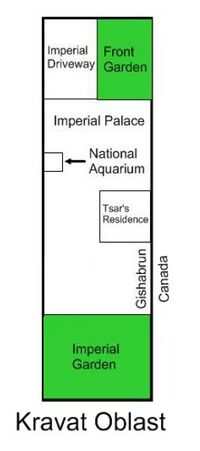Kravat Oblast
This article refers to a micronation or element of micronationalism which is defunct and no longer exists. You can help make the article reflect that or ask on the talk page for further information. |
Kravat Oblast
Краватская Область | |
|---|---|
Gishabruni Oblast | |
 | |
| Country | (2012 - 2015) |
| Founded | May 2010 |
| Dissolved | 5 May 2015 |
| Government | |
| • Ambassador | Kuri Kabanov |
| Area | |
| • Total | 0 km2 (0 sq mi) |
| Population | |
| • Total | 4 |
Kravat Oblast was a federal subject of the Tsarist Empire of Gishabrun and subsequently of Gishabrun SAR, Renasia. It was also the capital and among the most populous oblasts of Gishabrun.
Etymology
The name "Kravat" refers to the previous name of Gishabrun, the "Tsardom of Moya Kravat". The word Kravat (кровать) means "bed" in Russian, referring to the first territory captured by the micronation.
History
Tsarist Empire of Gishabrun
On the 5th of May, 2010, HIM Tsar Kuri I established the Tsardom of Moya Kravat on the territory of his bed, on what became Kravat Oblastian territory. The rival Principality of Annina Kravat also arose on on that land. Then, in May 2010, HIM Tsar Kuri I captured a tiny strip of land, completely surrounded by the Principality of Annina Kravat. This sparked tensions between the two young micronations, and soon after that Anna I of Annina Kravat declared what became known as the Furnace War. This war resulted in the Principality of Annina Kravat being conquered by Moya Kravat, and Kravat Oblast being founded to distinguish it from Annina Kravat Oblast.
Kravat Oblast expanded from just HIM Tsar Kuri I's room to his whole property (except for Annina Kravat), including the National Aquarium and the first regular parks: The Imperial and Front Gardens. The area of Annina Kravat Oblast was merged into Kravat Oblast on the 26th of July, 2010. Princess Anna I was unhappy about losing her status as an oblastian Ambassador, and so decided to run for the position of Ambassador of Kravat Oblast on the 24th of August, 2010. This election, the first in Gishabrun's history, resulted in HIM Tsar Kuri I being re-elected as Ambassador. On the 9th of October, 2010, Kravat Oblast was twinned with Patetopia City, in the Republic of Patetopia.
On the 9th of December, 2010, Kravat Oblast absorbed the nearby The Stig Oblast. The previous areas of the two oblasts becoming Communes with the same names as the former oblasts, with TH Jeremy Clarksoon becoming the first Mayor of the Commune of The Stig, and the position of Mayor of the Commune of Kravat being vacant, to be decided by a domestic election. On the 10th of December, 2010, the Commune of The Stig (and therefore Kravat Oblast) grew to include the whole property of TH Jeremy. Princess Anna I was elected Lord-Mayor of the Commune of Kravat on the 16th of December, 2010. Sometime in April 2011, the Commune of The Stig became its own oblast once again, under the name "The Stig Oblast" and the Ambassadorship of TRH Jeremy Clarksoon.
Gishabrun SAR
Kravat Oblast was retained as a land claim of Gishabrun SAR in Renasia, where it was the capital of the Special Autonomous Region. The 2013 Toronto Summit was hosted in part in Kravat Oblast on 29 August, 2013, which involved a state visit from Barnaby Hands, President of DES Senya.
Kravat Oblast was finally returned to Canadian sovereignty when Gishabrun transitioned to a non-territorial entity, on 5 May 2015.
Communes
Between 9 December 2010 and April 2011, Kravat Oblast consisted of two municipalities, known as 'communes'.
| Name | Date created | Date disestablished | Mayor | Maximum Population | Description |
|---|---|---|---|---|---|
| Kravat | 9 December 2010 | April 2011 | TH Princess Anna I (titled: Lord-Mayor) | 4 | This commune, the oblastian and national capital, contained the Imperial Palace. It bordered Ontario, Canada, and was disestablished when the Commune of The Stig became its own oblast. |
| The Stig | 9 December 2010 | April 2011 | TH Jeremy Clarksoon | 1 | This commune contained the residence of TH Jeremy Clarksoon and his family. It bordered Ontario, Canada, and was disestablished due to it being reorganised as The Stig Oblast. |
Geography

The climate of what was Kravat Oblast is continental (but modified by the nearby river with the Lake Effect), meaning it has an average of 9.5 degrees Celsius, with 133.1 cm of snowfall each winter and 834 mm of precipitation year-round. The area of Kravat Oblast is on the edge of a small valley, and has a steep cliff right outside the borders. Kravat Oblast contained the National Aquarium, the Imperial Palace, the Imperial and Front Gardens, and the headquarters of most Gishabruni agencies. Kravat Oblast was surrounded by Canada on all sides. Kravat Oblast's area was 255 square metres.
Sister cities
 Patetopia City, Republic of Patetopia (9 October 2010)
Patetopia City, Republic of Patetopia (9 October 2010)
